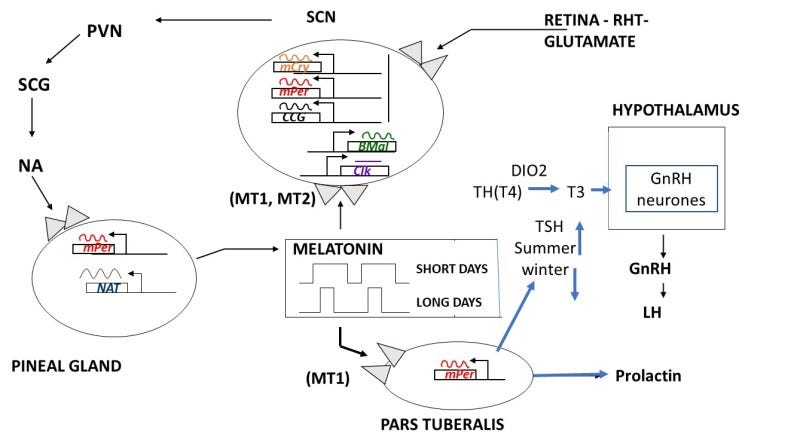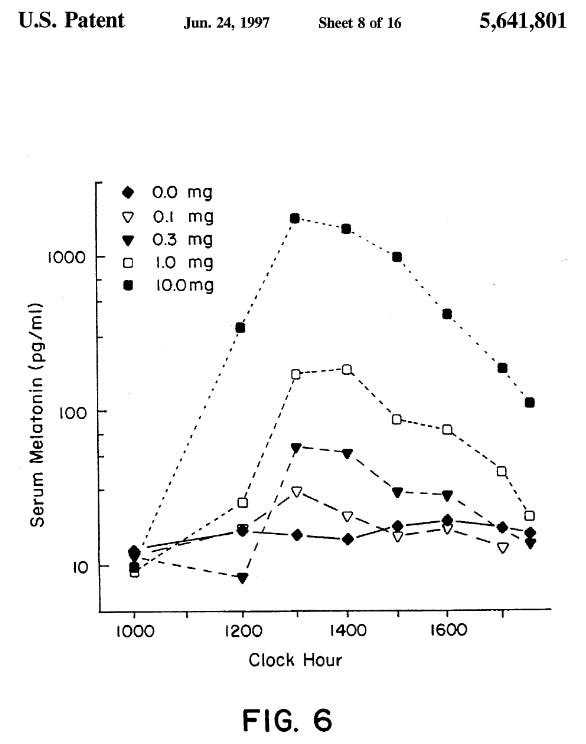TLDR: Exogenous melatonin is an effective hypnotic on par with nonbenzodiazepine sedative hypnotics (Ambien, etc.). The optimal dose of melatonin is 300 micrograms, approx. 1h before you plan on sleeping. Drugstores carry wrong doses due to idiosyncrasies in U.S. patent law. “Tranquilizing” doses of melatonin (3mg+) inhibit natural melatonin release/sleep in proceeding 72h. Beta-blockers (propranolol) inhibit endogenous melatonin release, and either should be supplemented with melatonin to prevent insomnia or used in conjunction with early-morning melatonin to flip your circadian rhythm at your whim.
Background
If you’ve read Scott Alexander’s Melatonin: Much More Than You Wanted To Know and his follow-up about the melatonin patent, this first section should be review.
Melatonin is a pretty interesting neurohormone. Secreted by the pineal gland in response to changes in light, melatonin acts on MT1 receptors found largely on the pars tuberalis to induce other hormonal changes and blah blah blah the hormone makes you sleepy.

Multiple meta-analyses show melatonin causes a decrease in sleep onset latency by 7.2 minutes and increases sleep duration by an average of 12.8 minutes. This doesn’t sound like much, but the medications physicians usually prescribe for sleep outside melatonin are the nonbenzodiazepine sedative hypnotics, who “as a group… reduce the average time to go to sleep 12.8 minutes compared [to placebo], and increase total sleep time 11.4 minutes.” So your prescription-only designer Ambien gets you to sleep on average 5 minutes faster than a $0.17/night melatonin pill you got on Amazon after reading this post, with approximately equal increased sleep, and with extra side effects to boot.
Some melatonin fun facts include:
It’s made from serotonin, and has since been implicated in depression.
high doses are used to induce apoptosis in metastatic cancer.
literally everyone gets the dosage wrong.
History of Melatonin
In 1992, Richard J. Wurtman of MIT demonstrated that 0.3mg of oral melatonin is sufficient “to raise the peak plasma level of melatonin in the individual to within physiological nocturnal levels of normal untreated individuals.” Normally our blood level of melatonin rests at around 10 picograms/milliliter, and then it spikes to 60-70 pg/ml at nighttime, with peak secretion around 2-4AM. Wurtman found that 0.3mg, or 300 micrograms of melatonin, gets digested to roughly mimic this peak, with excess doses vastly exceeding what occurs in our body normally.

MIT filed for a patent of “a single dose of melatonin of less than 1mg” in 1995, which the U.S. government then awarded in 1997. They specified the method of administration and the dosage because according to U.S. patent law, you can’t patent natural substances like normal pharmaceuticals, you can only patent the method of using them.
Which the entire pharmaceutical industry proceeded to sidestep by producing melatonin supplements in excess of 1mg.
To my knowledge, 1995 was right around the time melatonin became a “blockbuster” supplement (if I’m wrong, please correct me). The problem here is that dosages in excess of 1mg indeed work, but they nuke your body’s natural melatonin cycle. So when companies made 10mg melatonin gummies, they helped people get to sleep faster, which was confirmed experimentally, but the excess melatonin in their bodies messed up their natural circadian rhythm up to 72 hours after the initial ingestion.1 This makes sense since melatonin has a feedback mechanism on itself (see Fig. 1 of this post), where it inhibits the suprachiasmatic nucleus from sending signals down the pathway that leads to the pineal gland.
MIT’s patent on sub-1mg melatonin expired in 2014, but the economic inertia still remains. You can get 300 micrograms melatonin now easily, but you have to go out of your way to look for it. As of me writing this post, the default physician prescription of melatonin is 2mg, with dosages as high as 10mg “if you need it.”
And Now For Something Completely Different
Did you know beta blockers, the drug physicians use to slow your heart rate, inhibit melatonin secretion? The SCN→pineal gland pipeline uses adrenergic beta1-receptors, which are blocked by propranolol and similar drugs. This is hypothesized to be why one of the biggest side effects of beta-blockers is insomnia and nightmares. Luckily, co-administration of your beta-blocker with exogenous melatonin should alleviate this side effect.
So. hypothetically, we have a drug that can completely eliminate endogenous production of melatonin, as well as a way to safely administer exogenous melatonin. Hypothetically, this would allow someone to completely control their circadian rhythm by taking a beta-blocker (such as propranolol) approximately 30 minutes before they would naturally start to feel tired, as well as taking 300 micrograms exogenous melatonin one hour before they want to go to bed.
Interesting hypothetical, huh?
I realize this is one of the key arguments of my post, but I’ve searched for an hour and cannot find a paper that proves this. The most I found is this interview with a PhD saying melatonin dosages are bimodal. Without doxing myself too much, I took a class in college which involved melatonin and the professor made this claim. So trust me, a random internet stranger, on this one.


